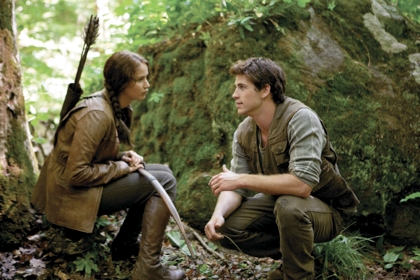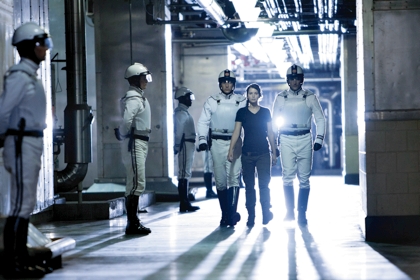Review
The Hunger Games

Returning to the audiovisual medium that inspired it, Suzanne Collins’s dystopian bestseller about televised mortal combat loses moral depth but gains some dramatic breadth, says Anton Bitel
The Hunger Games
USA 2012
Director: Gary Ross
Cast: Jennifer Lawrence, Josh Hutcherson, Liam Hemsworth, Woody Harrelson, Elizabeth Banks, Lenny Kravitz, Stanley Tucci, Donald Sutherland, Wes Bentley, Willow Shields
142 mins | Cert 12A
Synopsis
Our synopses give away the plot in full, including surprise twists.
The future, in the totalitarian nation of Panem. Every year, the 12 districts of Panem must select an adolescent boy and girl by ballot for the Hunger Games, a televised fight to the death. When her younger sister Primrose is chosen, skilled archer Katniss volunteers to take her place, securing a promise from hunting partner Gale to look after her family. Joined by baker’s son Peeta, Katniss is taken to the Capitol and trained by mentor (and past winner) Haymitch, who stresses the need to become popular with viewers and potential sponsors. Peeta declares his love for Katniss in a broadcast interview, with Haymitch’s approval.
In the woodland arena, Katniss evades the initial bloodbath. Stuck up a tree, with an alliance of five (including Peeta) waiting to kill her below, she drops a nest of deadly, genetically altered wasps on her pursuers; she is stung herself, but Peeta helps her to escape. Katniss joins forces with young Rue, and in a sneak attack destroys the other group’s provisions. When Rue is trapped, Katniss kills the girl’s attacker, but is too late to save her.
It is announced that this year, two contestants from the same district can win. Finding Peeta severely injured, Katniss sets off to find medicine; she is rescued from attack by Rue’s district companion. Mutant dogs drive Katniss and the healed Peeta to the only other survivor, Cato, who is killed. Instructed to fight each other after all, Katniss and Peeta threaten to commit lovers’ suicide together, and are declared joint victors.
Review
Panem et circenses – bread and circuses – is how the satirist Juvenal described the empty distractions doled out by Rome’s political elite to appease and stultify the plebs. Panem is also, significantly, the name of the post-apocalyptic dystopia in Suzanne Collins’s bestselling 2008 ‘young adult’ novel The Hunger Games, in which a decadent Capitol keeps its proletarian subjects in check with an annual gladiatorial circus, televised live as a tool of mass entertainment/oppression, and ‘performed’ by 12 pairs of adolescent male and female ‘tributes’ chosen by lot from their respective districts. In an expansive, controlled arena, the victor is the last boy or girl left standing.
Collins got the idea for her novel (and its two sequels) from channel-surfing between reality-television programming and actual war footage, making it appropriate that her story should return to the audiovisual medium that originally inspired it and that features so prominently in it. Of course this sort of material has previously appeared in films as diverse as Punishment Park (1971), Rollerball (1975), The Running Man (1987), Battle Royale (2000) and Series 7: The Contenders (2001) – but never before has it been targeted specifically at a tween/teen demographic.
The result feels somewhat compromised: a film built around a grand spectacle of violence, brutality and death, but one that carefully avoids reproducing such spectacle for its young, impressionable viewers. Combat scenes are largely presented in a blurry handheld style that implies carnage without showing it directly (and in Britain, seven seconds of footage were subjected to “visual cuts, visual darkenings and the digital removal of sight of blood” at the request of the BBFC, to enable the granting of an all-important 12A certificate).

What remains is a triumph of restraint – but had the film been more visceral and less sanitised it might have better implicated viewers in the voyeuristic bloodlust of its entertainment, leading to (uncomfortable) identification with the Capitol’s grotesque, baying crowds. As it is, we are let off the hook, invited to tut at the screen in easy moral disapproval, and never confronted with our own ugly reflection.
Similarly disappointing are subtle changes to the characterisation of central protagonist Katniss (Jennifer Lawrence). Her first kill, expressly an act of vengeful rage in the novel, becomes a defensive reflex in the film; and where in the novel her relationship-in-the-spotlight with fellow competitor Peeta (Josh Hutcherson) is portrayed equivocally, only to be devastatingly disambiguated in the final pages, in the film the ambiguity is maintained, in service to the inevitable sequel. The effect is to transform a complicated, difficult figure into a less interesting saint.
Still, Lawrence brings an intense conviction to the role, and her previous, similar turn in Winter’s Bone (2010) helps flesh out, through cinematic shorthand, a character whom we get to know in the novel through an internal monologue thankfully absent here. Meanwhile, Katniss’s original first-person narrative and restricted perspective are wisely replaced with regular cutaways to the control room, commentary box and presidential garden – lifting the curtain on the whole macabre circus.
See also
Coriolanus reviewed by David Jays (February 2012)
Daddy cool: James Mottram on Bully (March 2002)
Series 7: The Contenders reviewed by Mark Kermode (June 2001)
Titus reviewed by John Wrathall (October 2000)
Gladiator reviewed by Leslie Felperin (June 2000)
Any Given Sunday reviewed by Mark Kermode (April 2000)
Burn, blast, bomb, cut: J. Hoberman on Three Kings and the television spectacle of Operation Desert Storm (February 2000)
Credits
- Produced by
- Nina Jacobson
- Jon Kilik
- Screenplay
- Gary Ross
- Suzanne Collins
- Billy Ray
- Based on the novel by Suzanne Collins
- Director of Photography
- Tom Stern
- Edited by
- Stephen Mirrione
- Juliette Welfling
- Production Designer
- Philip Messina
- Music
- James Newton Howard
- Sound Design & Supervision
- Lon Bender
- Costume Designer
- Judianna Makovsky
- Visual Effects
- Hybride Technologies
- Rising Sun Pictures
- Clearcut FX
- Pixomondo
- Digiscope
- Whiskytree Inc.
- Visual Effects & Animation
- Rhythm & Hues Studios
- Stunt Co-ordinator
- Chad Stahelski
